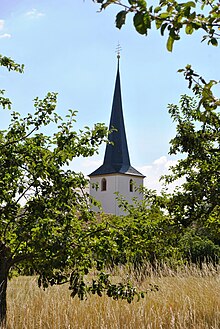St. James the Elder (Kirchschönbach)
The church of St. Jakobus the Elder in Kirchschönbach in Lower Franconia is the parish church of the Prichsenstadt district. The church is located on Kreisstrasse KT 46. Today the church is part of the Kitzingen deanery .
history
The village of Kirchschönbach was first mentioned in a document in 1230. It is unclear where the church stood, which at that time already existed in the village. What is certain, however, is that the original church building was assigned to the parish of Stadtschwarzach before the parish was raised to a parish on October 1, 1324. Previously, in 1306, the rulership of the village had passed from the Counts of Castell to the Münsterschwarzach monastery .
In the late Middle Ages, Kirchschönbach came to the Fuchs von Dornheim . Valentin Fuchs von Dornheim introduced the Reformation in the village around 1550, and a first Protestant pastor has been recorded for 1564. Just a few decades later, the Counter-Reformation began under Prince-Bishop Julius Echter von Mespelbrunn , so that the village had completely converted to Catholicism in the 16th century. At the same time, the bishop's brother, Valentin , had a new church built.
But already the Thirty Years War changed the denominational conditions again. The Protestant Swedes conquered Mainfranken in 1631 and Kirchschönbach became Protestant again by 1634. At that time the believers were also cared for from Oberschwarzach . After the long war, a period of recovery followed. At that time, the pastor of Kirschönbach was also the pastor in nearby Wiesentheid.
It was not until September 3, 1803 that the parish of Kirchschönbach was re-established by the electoral state administration. For a few decades the late Gothic house of God was described as dilapidated. The church was torn down except for the tower in 1872 and was rebuilt in the neo-Gothic style by 1873. In 1956 a comprehensive interior renovation was carried out. The structure and equipment were also renewed from 1985 to 1987. The Bavarian State Office for the Preservation of Monuments has classified the church as an architectural monument , underground remains of the previous buildings are listed as a ground monument .
architecture
The church presents itself as a hall building . It is north and ends with a polygonal choir. In the north-west, the tower connects to the church, which is the oldest element of the building. It was completed in 1607 and ends with a real pointed helmet . The nave and choir were built in 1872 in the neo-Gothic style. The church is lit on both sides by five simple pointed arch windows.
The south facade also has three simple pointed arch windows. The portal has a decorated tympanum and ends with a cross at the top. It has a rich valley. A large ox-eye was installed above the window, and a clock is located directly under the gable roof of the nave. Inside the tower has a net vault with rich stucco, the nave, on the other hand, has a flat roof.
Furnishing
Bells
The church bell consists of a total of three bells. They came to the house of God at very different times. The oldest was created around 1300, and another was created at the end of the 14th century. The third bell was melted down during the Second World War, so that a replacement could not be found until 1950.
| Surname | Keynote | Casting year | Diameter in centimeters | Weight in kilograms | inscription |
|---|---|---|---|---|---|
| James Bell | as' | 1950 | 100 | 480 | "St. Jakobus, protect our community "," Karl Czudnochowsky Bachmair successor to Erding, Obb. 1950 "poured me out" |
| Evangelist bell | c ' | around 1300 | 86.5 | 380 | "SVEHTAM SACVL (Mattheus, Lucas backwards) S. IOHANNES MARCVS" |
| John the Evangelist bell | it'' | Late 14th century | 70.5 | 210 | "S. IOHANNES EWA BERTHOLDVS DE BABERCH " |
Further equipment
Most of the furnishings were added to the church as part of the interior renovation in the 1950s. The sacrament altar was created in 1956 by Max Becher from Würzburg . In the same year the simple wooden pulpit with the names of the four evangelists in the body was built. In addition, several figures were created at this time. The organ is a little older, from 1935 . It was created by the company Weise from Plattling.
In the choir head you can find the former altarpiece with the coronation of Mary, which dates from the 18th century. Two figures, St. John Nepomuk and Maria Immaculata, are hung on the choir arch . Two simple sandstone side altars hold two figures: to the west is St. Joseph with the child from the 19th century, while to the east is a Pietà from the early 16th century. The font is from 1604.
literature
- Hans Bauer: District of Kitzingen. An art and culture guide . Market wide 1993.
- Karl Treutwein : From Abtswind to Zeilitzheim. History, sights, traditions . Volkach 1987.
- Thomas Wehner: Real Schematism of the Diocese of Würzburg. Kitzingen Dean's Office . Wuerzburg 1997.
Web links
Individual evidence
- ^ A b Wehner, Thomas: Real Schematism of the Diocese of Würzburg . P. 90.
- ^ Bauer, Hans: District of Kitzingen . P. 72.
- ^ Treutwein, Karl: From Abtswind to Zeilitzheim . P. 125.
- ↑ Wehner, Thomas: Real Schematism of the Diocese of Würzburg . P. 91.
Coordinates: 49 ° 48 '53.1 " N , 10 ° 23' 11.6" E


